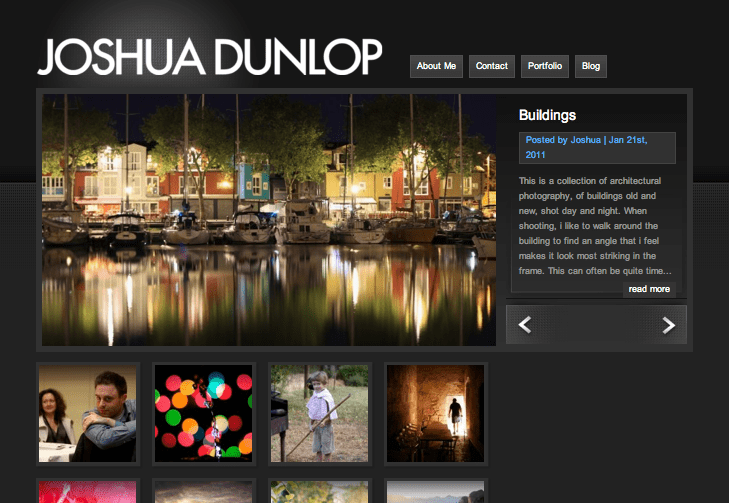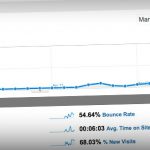There’s a learning curve when it comes to blogging, and that curve for me was my first blog that failed to get any real traffic. Here’s a list of 9 things that I did wrong on my first blog and how you can avoid them when starting yours.
Useless Domain Name
My first problem was that I was writing a blog from my personal portfolio at www.JoshuaDunlop.com, which isn’t necessarily a bad thing if you’re a well established photographer, but when you’re just starting out, that domain name says absolutely nothing about what your blog is about to any potential readers. You need to include a keyword from your niche in the domain name of your blog, just like i did with my new website; www.ExpertPhotography.com.
My domain name contains 2 keywords; expert and photography. The expert part implies that we’re an authority site, and the photography part tells the reader what we’re writing about. This is important for getting recognized in google and drawing interest into your site when someone sees a link to it. This step makes a noticeable difference to the number of visitors and as you’re going to be sticking with it for the rest of the site’s life, you may as well invest some money into it.
Horrible Design
If you had a look at my site, you would have notice that it’s not really ideal for writing long blog posts with grey writing on a black background. Because of the theme that I was using there was very little customisation that I could do to it to make it look better without sacrificing the look of my website. Using a proper theme for blogging, like a Woo theme, made all the difference and we were able to customise it in a number of ways.
- We included a custom header with images that reflected the nature of our website.
- Found a featured slider that worked for what we wanted to display, and because we’re using WordPress, there were loads to choose from.
- Could place adverts exactly where we wanted them which makes us money.
- Used a much better colour scheme that’s easy on the eyes when reading.
- The blog post template was laid out better, making the content easier to read.
Using WordPress allows you to customise your site to help it to stand out from the rest of the sites on the internet. Poorly laid out websites lose visitors quickly, so we implement related posts and categories to help the visitors stay on the site for longer.
Poor Writing
It’s easy to start a blog these days, and I would encourage everyone to give it a go, you just need to know what you’re writing before you start. If you can’t provide valuable insightful information that can’t be found many other places, then people don’t want to read it. Plan your blog posts properly and research them well, and you’re halfway to writing good content.
Whenever I write a post, the first thing I do is google the title i’m going to use; not to copy everyone else’s writing, but to see what’s out there so I know what I have to do to make mine better. I strive to write the best content for my niche on the internet, and to do that you’ve really got to put in some time and effort into it, but if you know what you’re writing about, it’s not hard. I think the main reason I find so much useless information on the internet is because people aren’t willing to put in the time it takes to write good content, and that’s a good thing for you, because it makes it that much easier to write better than them.
Wasn’t Writing Enough
If you really want to build a daily following, you need daily content. I’ve written before on how to direct traffic to your website, but that’s wasted if you’re not spending the time it takes to write content regularly. It’s going to take a very long time to build up regular traffic through google or other means if you only write once a month. When I started my first blog, I would write when I felt like it, but now I set myself a task of writing a minimum of 3 posts a week, and extra smaller posts when I can.
Same Old Thing
The internet is packed full of billions of webpages, and yours is one of them. If you want to get noticed, you need to stand out, and to do that you need to think carefully about what you’re writing about. Are you just churning out the same thing everyone else is? How can you make yours different? What’s your USP? What can you provide to your blog posts that make them more valuable and insightful to your readers then anyone else can?
I write in a variety of different styles on many different topics, but along with the educational tutorials and top lists, I include a series called ‘Shoot My Shot’ where I can show readers the steps I took to take my photo; something that not many people are doing on the internet. This is something I took on when my new blog went up, as I knew it was different and would draw in a different type of reader then before, which helps my blog grow.
It Wasn’t a Priority
When I started, I wasn’t really taking it seriously, the idea was that it would bring traffic to my portfolio if I got into Google for my tutorials. This is why a lot of people start blogs, but the problem is that you don’t really take it that seriously. You need to think of your site as a business that it’s going to potentially earn you a lot of money.
Once you change your mindset, you start to think about it in your daily life, and it helps to improve your website as you come up with new ideas. As a photographer, I see everything as a potential photo, and the same is true with being a blogger, I see potential blog posts in everything these days. For me, coming up with a good topic to write was half the battle, the writing part is the easy bit.
Didn’t Market The Site
I didn’t understand how websites worked back when I started, and I thought that if I wrote enough content I would eventually be in google and the challenge would be over. Now, I spend probably as much time working on the marketing side as I do the writing side, as it’s just as important. As we all know, the best type of marketing is free marketing, and this is remarkable easy to do these days if you know what you’re doing; particularly if you’re using social networking to help you.
Facebook and Twitter are the some of the best ways to drive traffic to your site; Facebook is direct contact with a reader and twitter has the ability to be retweeted and shared by other people without you even having to do anything. Not only does this directly send traffic to your site, but Google recognises it and you’ll start to see more traffic from them too.
Facebook is the best way to maintain a following as the quality of visitor is much better, they’re someone who is willing to have your information in their newsfeed along with all their friend’s updates. Start a fan page as soon as you start your website and start on building a following immediately, it takes very little work and the results are great.
Twitter is similar to Facebook in that your updates will appear in other people’s feeds, the only problem is that they may get thousands a day, and yours will just be lost in the mess. From a tweet for roughly 1600 followers, I get between 50-60 people actually click on the link, which isn’t really that good, but that’s not the main reason I use twitter. The retweet function and the ability for other people to post your links has a huge effect on the amount of traffic you get to your website.
I Wasn’t Working on Google Traffic
Recently, someone at Adobe Lightroom found a tutorial of mine that I wrote months ago and tweeted it to 30,000 of their followers with an @photojosh tag on it. That then got retweeted to roughly 15,000 more people and drove about 5,000 visitors to my site in just 2 days, which is a big deal to me. Great to get traffic like that and Adsense certainly felt the impact, but the main, long term result of that is something I wasn’t expecting – my hits in Google went WAY up. Have a look below at my 2 screen shots, the first one is a timeline of the traffic I was getting to my website and the second one is a graph of the number of hits that came through search engines. 

There’s obvious correlation between the amount of unique visitors I got in a day and the amount of traffic I got through search engines in the graphs above. Before June (about halfway along the timeline) My traffic was all over the place and my search engine visitors ranged from anywhere from 0-10 a day. I published an article on the most influential photographers, and that got everyone visiting at the beginning of June and after that the following started to grow, along with the search engine traffic, which went up to between 10-30 a day.
Although my recent boost in traffic isn’t the most i’ve had in a single day, search engines have started to notice people sharing my website through social networks like Twitter and that’s resulted in a sustained increase in traffic. The key is to write articles that are either really damn good, or a little controversial so that people will talk about them on the internet and then Google will recognise it and you’ll start seeing more traffic to your site for posts that you wrote months ago.
No Reader Interaction
I wasn’t really paying too much attention to what people wanted to learn on my old blog, and I was mostly writing for myself and starting at the beginning. Now that my new site has grown, and people comment, I like to comment back and help them with any questions that they may have. In fact, at the end of every post, I encourage people to comment and ask for help so I can build reader interaction and get people talking about my site. These small gestures, which take very little time, make the site a load more personal and welcoming to your readers.











